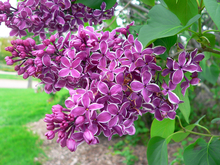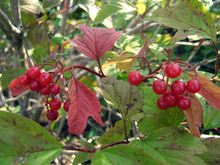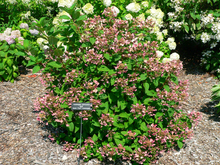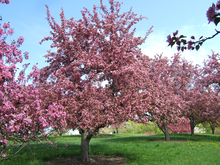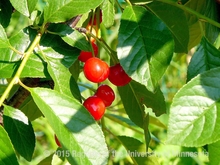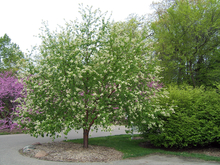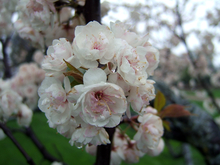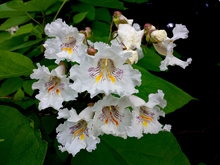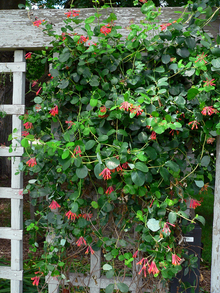Annual and perennial flowers are popular choices to attract pollinators to our yards and gardens. But there are many trees, shrubs and vines that are also favorites of bees, butterflies and other pollinators.
You can add seasonal interest to your landscape while providing food and habitat for beneficial insects and birds.
Shrubs
Shrubs can be planted in close groups to form a hedge or stand on their own to lend their wide variety of textures, sizes and colors to any landscape. Some provide dense habitat for pollinators while others are great sources of food and pollen. Fruiting varieties may rely on pollinators for reproduction.
Carefree Delight™ (Rosa 'Carefree Delight'): 1.5-inch single, slightly cupped pink flowers with a white eye bloom throughout the season. Flowers are in large clusters of up to 10 blossoms. Lightly fragrant. Dark green foliage. Small red fruits in autumn. Canes up to 5 feet long. 1996 AARS winner. Own root. Requires winter protection.
Nearly Wild (Rosa 'Nearly Wild'): Single pink flowers with apple scent. Own root. Dies back to crown most winters but renews quickly each spring.
Purple Pavement (Rosa 'Rotesmeer'): Fragrant semi-double repeated blooms. Flowers are purplish-red with bright yellow stamens. Dark red hips. Own root.
Winnipeg Parks (Rosa 'Winnipeg Parks'): Cherry red flowers through summer red hips in fall. Parkland rose. Own root. Dies back to crown in winters; recovers quickly in spring. Hybridized by Collicutt; registered in 1981.
Select any image to enlarge.
Rose bushes for pollinators
| Common Name | Scientific Name | Cultivar/Variety | Height | Spread | Light | Zone |
|---|---|---|---|---|---|---|
| Carefree Delight™ Rose | Rosa | Carefree Delight | 4 ft. | 4 ft. | Full sun | 4-7 |
| Nearly Wild Rose | Rosa | Nearly Wild | 3 ft. | 2 ft. | Full sun | 4-9 |
| Purple Pavement Rose | Rosa | Rotesmeer | 3 ft. | 3 ft. | Full sun | 3-7 |
| Winnipeg Parks Rose | Rosa | Winnipeg Parks | 3 ft. | 3 ft. | Full sun | 3-7 |
Miss Kim lilac (Syringa patula 'Miss Kim'): Late spring purple flowers. Large leaves that turn burgundy-red in fall. Originally from Korea. Also known as Syringa velutina.
Common purple lilac (Syringa vulgaris): Very fragrant purple flowers in spring with blue-green foliage. Traditional old-fashioned lilac.
Sensation lilac (Syringa vulgaris 'Sensation'): Single purple florets with distinctive pure white borders. Fragrant spring flowers. A mutation of'Hugo de Vries', a very unique French hybrid.
Select an image to enlarge.
Lilacs for pollinators
| Common Name | Scientific Name | Cultivar/Variety | Height | Spread | Light | Zone |
|---|---|---|---|---|---|---|
| Miss Kim Lilac | Syringa patula | Miss Kim | 7 ft. | 6 ft. | Full sun | 3-7 |
| Common Purple Lilac | Syringa vulgaris | 15 ft. | 12 ft. | Full sun | 2-7 | |
| Sensation Lilac | Syringa vulgaris | Sensation | 10 ft. | 12 ft. | Full sun | 3-7 |
The table at the end of these descriptions details size and growing conditions for each variety.
Select an image to expand and see the full view.
Regent serviceberry (Amelanchier alnifolia 'Regent'): Fragrant white flowers emerge in early spring. Sweet, edible purple-black fruit. Shrub form of the native serviceberry. Bred for fruit production. A good alternative to the tree form.
Glossy black chokeberry (Aronia melanocarpa var. elata): White spring flowers. 1/4-inch black fruits persist into winter. Very tart, but edible fruit. Brilliant red fall foliage. Great ornamental shrub. Very hardy and adaptable. Blooms on old wood. Prune after blooming.
Latham raspberry (Rubus 'Latham'): Summer bearing type. Delicious edible fruit. Self-fruitful. Introduced in 1920 by the University of Minnesota. Red fruit ripens over a long period. Good for home or commercial use.
Coralberry (Symphoricarpos orbiculatus): Flowers are yellow-white or flushed rose in June or July. Purplish-red berry-like fruit for birds and other wildlife in fall through mid-winter. Prune in early spring so the current season's growth can produce flowers and fruit. Good in shade or sun and on bank plantings. A spreading shrub with slender arching branches. Tolerant of most soils.
Northsky blueberry (Vaccinium 'Northsky'): Summer sky-blue, sweet, edible fruit with 'wild' flavor. Glossy green foliage turns red in fall. Introduced in 1983. One of the shortest of the half-high blueberries. Yields benefit from cross-pollination.
Select any image to enlarge.
Deciduous fruit-bearing shrubs up to 6 feet tall
| Common Name | Scientific Name | Cultivar/Variety | Height | Spread | Light | Zone |
|---|---|---|---|---|---|---|
| Regent Serviceberry | Amelanchier alnifolia | Regent | 6 ft. | 6 ft. | Full Sun; Part shade | 2-7 |
| Glossy Black Chokeberry | Aronia melanocarpa var. elata | 6 ft. | 6 ft. | Full sun; Part sun | 3-7 | |
| Gold Fruited Winterberry | Ilex verticillata | Winter Gold | 5 ft. | 8 ft. | Full sun; Part shade | 3-9 |
| Latham Raspberry | Rubus | Latham | 5 ft. | 3 ft. | Full sun | 4-7 |
| Coralberry | Symphoricarpos orbiculatus | 5 ft. | 8 ft. | Full sun; Part sun | 4-7 | |
| Northsky Blueberry | Vaccinium | Northsky | 1.5 ft. | 36 ft. | Full sun | 4-8 |
American hazelnut (Corylus americana): Male catkins and female flowers with thread-like stigma and styles in spring. Round, edible nuts in clusters of 2-4 in fall.
Nanking cherry (Prunus tomentosa): Flowers bloom in early spring before leaves emerge. Red fruits ripen in mid to late summer. Small, sweet fruit is excellent for eating, jams and jellies. Wildlife also loves the fruit. A great conservation plant.
Flowering almond (Prunus triloba): April-May pink flowers. Ornamental. Red fruit for wildlife.
Red berried elder or scarlet elder (Sambucus pubens): May, white flowers. June, scarlet fruit attractive to wildlife and birds; should be cooked before eating as raw fruit can cause stomach problems. Fall yellow foliage. Native shrub in Minnesota. Good background shrub for borders.
Nannyberry (Viburnum lentago): June, white flowers. Red-purple foliage in summer. Fall, blue-red fruits that have a sweet, date-like flavor when ripe, attract wildlife. Native species with great durability. Prefers moist fertile loamy soils.
American cranberrybush (Viburnum trilobum): May, white flowers. Edible, red fruits in fall persist into winter. Lobe-shaped leaves.
Select any image to enlarge.
Deciduous fruit-bearing shrubs over 6 feet tall
| Common Name | Scientific Name | Height | Spread | Light | Zone |
|---|---|---|---|---|---|
| American Hazelnut | Corylus americana | 8 ft. | 8 ft. | Full sun; Part sun | 3-9 |
| Nanking Cherry | Prunus tomentosa | 10 ft. | 15 ft. | Full sun | 2-6 |
| Flowering Almond | Prunus triloba | 10 ft. | 9 ft. | Full sun | 4-8 |
| Red Berried Elder or Scarlet Elder | Sambucus pubens | 11 ft. | 15 ft. | Full sun; Part sun | 3-6 |
| Nannyberry | Viburnum lentago | 20 ft. | 12 ft. | Full sun; Part sun | 2-8 |
| American Cranberrybush Viburnum | Viburnum trilobum | 10 ft. | 10 ft. | Full sun; Part sun | 2-7 |
New Jersey Tea (Ceanothus americanus var. pitcheri): Small plumes of fluffy white flowers in summer. Butterfly garden plant.
Kalm's St. John's Wort (Hypericum kalmianum): Broadleaf semi-evergreen shrub. Summer bright yellow flowers. Seed pods persist into winter. Flowers bloom mid-late summer. Blooms on new wood.
Miniature Snowflake Mock Orange (Philadelphus × virginalis): Very fragrant double white flowers with disease-resistant foliage. Compact, prolific bloomer selected for its dwarf habit and excellent flowering. Blooms on old wood.
Abbotswood Potentilla (Potentilla fruticosa 'Abbotswood'): Large white flowers from early spring to late fall.
Dakota Goldrush® Potentilla (Potentilla fruticosa 'Absaraka'): Flowers all summer, especially late in the season. Introduced by NDSU. Smaller than 'Jackmann' with more flowers.
Dwarf Blue Leaf Arctic Willow (Salix purpurea 'Nana'): Fuzzy spring buds; soft, blue-green summer foliage. Fine-textured twigs are a mixture of green, red and silver giving plant winter interest. Makes an attractive hedge. Very hardy. One-year heavy branched hardwood cuttings (25/bundle). Larval food source for mourning cloak, viceroy, red-spotted purple and Sylvan hairstreak butterflies.
Tor Birchleaf Spirea (Spiraea betulifolia 'Tor'): Full bloom in late spring with sporadic flowers later. Red-purple fall color. Compact mound of dark gray-green birch-like leaves.
Little Princess Spirea (Spiraea japonica 'Little Princess'): Summer pink flowers. Dark red fall color. Similar to Daphne Spirea.
Crisp Leaf Spirea (Spiraea × bumalda 'Crispa'): Pink flower clusters in late June and throughout summer. Summer foliage is red-tinged, crinkled and twisted. New growth is an attractive burgundy red. Cut blooms to produce additional blooms.
Select an image to enlarge.
Shrubs under 6 feet tall
| Common Name | Scientific Name | Cultivar/Variety | Plant Type | Height | Spread | Light | Zone |
|---|---|---|---|---|---|---|---|
| New Jersey Tea | Ceanothus americanus var. pitcheri | Deciduous shrub | 3 ft. | 2 ft. | Full sun; Part shade | 4-8 | |
| Kalm's St. John's Wort | Hypericum kalmianum | Broadleaf semi-evergreen shrub | 3 ft. | 3 ft. | Full sun; Part shade | 4-7 | |
| Miniature Snowflake Mock orange | Philadelphus x virginalis | Miniature Snowflake | Deciduous shrub | 4 ft. | 3 ft. | Full sun; Part sun | 4-8 |
| Abbotswood Potentilla | Potentilla fruticosa | Abbotswood | Deciduous shrub | 4 ft. | 4 ft. | Full sun | 2-7 |
| Dakota Goldrush® Potentilla | Potentilla fruticosa | Absaraka | Deciduous shrub | 4 ft. | 4 ft. | Full sun; Part sun | 2-7 |
| Dwarf Blue Leaf Arctic Willow | Salix purpurea | Nana | Deciduous shrub | 4 ft. | 6 ft. | Full sun | 4-8 |
| Tor Birchleaf Spirea | Spiraea betulifolia | Tor | Deciduous shrub | 3 ft. | 3 ft. | Full sun | 3-8 |
| Little Princess Spirea | Spiraea japonica | Little Princess | Deciduous shrub | 2.5 ft. | 3 ft. | Full sun; Part sun | 4-8 |
| Crisp Leaf Spirea | Spiraea xbumalda | Crispa | Deciduous shrub | 3 ft. | 4 ft. | Full sun; Part sun | 4-8 |
Red Twig Dogwood (Cornus sericea 'Baileyi'): Porcelain-blue fruits. Excellent red stems in winter. Blooms on old wood. Young stems are the brightest red.
Leatherwood (Dirca palustris): Sturdy and attractive foliage is pale yellow in spring, deep green in summer, and golden yellow in fall. White, irregular flowers emerge in clusters in early spring. "Dirca" refers to a mythical spring near Thebes. "Palustris" refers to the plant's boggy or wetland habitat. Multi-stemmed.
Witchhazel (Hamamelis virginiana): Fragrant fall yellow flowers and foliage. Flowers bloom in late fall about leaf-drop. Blooms on old wood.
Quick Fire Hydrangea (Hydrangea paniculata 'Bulk'): Early flowering. Flowers fade from white to pink to red as they age. Leave flower heads on through winter for winter interest.
Pussy Willow (Salix discolor): Silvery-orange catkins appear before leaves in spring. Deep brown branches give plant winter interest. Hardiest of the pussy willows. Can form a large shrub or small tree.
Select an image to enlarge.
Deciduous shrubs over 6 feet tall
| Common Name | Scientific Name | Cultivar/Variety | Height | Spread | Light | Zone |
|---|---|---|---|---|---|---|
| Red Twig Dogwood | Cornus sericea | Baileyi | 10 ft. | 10 ft. | Full sun; Part sun | 2-7 |
| Leatherwood | Dirca palustris | 10 ft. | 6 ft. | Full shade; Part shade | 4-7 | |
| Witchhazel | Hamamelis virginiana | 15 ft. | 15 ft. | Full sun; Part sun | 4-8 | |
| Quick Fire Hydrangea | Hydrangea paniculata | Bulk | 7 ft. | 8 ft. | Full sun | 4-8 |
| Pussy Willow | Salix discolor | 20 ft. | 15 ft. | Full sun | 2-7 |
Trees
If you have space in your yard, there are many trees that are attractive to pollinators. These recommendations will provide you with seasonal interest throughout the year: flowers in the spring, leafy shade in the summer, fruit or seeds in the fall, and interesting color and texture in winter.
Apple, crabapple and pear trees all produce lovely and fragrant blooms that attract many different pollinators. Most varieties rely on bees for pollination and to produce fruit.
Red Splendor crabapple (Malus): An abundance of pink flowers emerge in spring. Red fruits form in fall and persist into winter. Glossy summer foliage is reddish-green and turns reddish-purple in fall. Developed by Melvin Bergeson of Fertile, Minnesota. Fruit rarely falls, so tree litter is minimal. Blooms on old wood.
Sugar Tyme® crabapple (Malus): Spring white flowers followed by red fruit, which persists through winter and for several years. Crisp green foliage in summer. A 1999 Michigan Growers' Choice Award winner. Excellent plant. Good for pollinators. Blooms on old wood.
Zestar!® apple (Malus 'Minnewashta'): White spring flowers. Large, crunchy, juicy red fruit with a balanced sweet-tart flavor. University of Minnesota release 1999. Apples store for 6 to 8 weeks. Good bee tree.
'Summer Crisp' pear (Pyrus 'Summer Crisp'): Ripens in mid-August. Late summer yellow fruit. Pick when the fruit is still green. Will store up to two months. Released by the University of Minnesota in 1985. Use either 'Parker' or 'Patten' as a pollinator.
The table at the end of these descriptions details size and growing conditions for each variety.
Select an image to enlarge.
<em>Malus</em> varieties for pollinators
| Common Name | Scientific Name | Cultivar/Variety | Height | Spread | Light | Zone |
|---|---|---|---|---|---|---|
| Red Splendor Crabapple | Malus | Red Splendor | 25 ft. | 20 ft. | Full sun | 3-7 |
| Sugar Tyme® Crabapple | Malus | Sutyzam | 20 ft. | 15 ft. | Full sun | 4-7 |
| Zestar!® Apple | Malus | Minnewashta | 14 ft. | 10 ft. | Full sun | 4-7 |
| Summer Crisp Pear | Pyrus | Summer Crisp | 15 ft. | 12 ft. | Full sun | 4-8 |
The Prunus family includes cherries, plums, peaches and almonds. They are grown for their fruit and their beautiful spring blossoms.
North Star cherry (Prunus 'North Star'): An abundance of fragrant white flowers emerge early in spring. Bright red summer fruit with small stone ripens late in June. A sour pie cherry used for sauce pies and freezing. Self-fertile. Very productive. Good for pollinators. Genetic dwarf introduced by the University of Minnesota in 1950.
Pin cherry (Prunus pensylvanica):Spring white flowers. Fall yellow-red foliage. Good food plant for birds and pollinators. Fruits can be made into jelly. Suckers and self-seeds.
Amur chokecherry (Prunus maackii):Clusters of small white flowers emerge in spring. Black fruit forms in fall. Cinnamon-brown exfoliating bark with a glistening metallic appearance gives plant winter interest. Single trunk or clump form available (clumps will have two or more stems). Not a long-lived tree.
Chokecherry (Prunus virginiana): Racemes of white blooms flower in May and are followed by small, dark purple edible fruit good for jelly. Dark green foliage. A small suckering tree or large shrub with an oval to rounded crown ideal for naturalizing. Provides food and habitat for wildlife.
American plum (Prunus americana): Fragrant, delicate, white flowers emerge before the foliage in spring. Edible red-yellow fruits form in the fall; fruit makes delicious jam. Green summer foliage turns yellow in fall. Small hardy tree. Suitable pollinator for other fruiting plums. Suckering habit.
Princess Kay plum (Prunus nigra 'Princess Kay'): Large, fully double, fragrant white flowers bloom for 7 to 10 days before the foliage emerges in spring. A double-flowered selection of Canadian wild plum. Native to Minnesota. Double flowers mean very little fruit is set. Blooms freely at a young age.
Toka plum (Prunus 'Toka'): A medium red fruit with yellow flesh. Use another plum for pollination. Red - South Dakota Experiment Station introduction, 1911. One of the best pollinators.
Select an image to enlarge.
<em>Prunus varieties</em>
| Common Name | Scientific Name | Cultivar/Variety | Height | Spread | Light | Zone |
|---|---|---|---|---|---|---|
| North Star Cherry | Prunus | North Star | 11 ft. | 8 ft. | Full sun | 4-8 |
| Pin Cherry | Prunus pensylvanica | 30 ft. | 20 ft. | Full sun | 3-6 | |
| Amur Chokecherry | Prunus maackii | 30 ft. | 30 ft. | Full sun | 2-6 | |
| Chokecherry | Prunus virginiana | 25 ft. | 20 ft. | Full sun | 2-7 | |
| American Plum | Prunus americana | 20 ft. | 15 ft. | Full sun | 2-5 | |
| Princess Kay plum | Prunus nigra | Princess Kay | 15 ft. | 10 ft. | Full sun | 2-6 |
| Toka Plum | Prunus | Toka | 20 ft. | 15 ft. | Full sun | 3-8 |
Many other fruiting and flowering trees are suitable for attracting pollinators to your yard. The table at the end of these descriptions details size and growing conditions for each variety.
Red maple (Acer rubrum): April scarlet flowers fall red foliage; winter grey bark and red flower buds. Fall color is dependent on the site; chlorotic on high pH soils. Red flowers emerge in spring before leaves. Intolerant of alkaline soils.
'Snowcloud' Shadblow serviceberry (Amelanchier laevis): Large white flowers emerge in early spring. Purple-black fruit forms in summer. Green summer foliage turns copper-orange in fall. Blooms on old wood. Prune after blooming.
Northern catalpa (Catalpa speciosa): Late spring flowers are orchid-like and very fragrant. Large heart-shaped foliage gives plant summer interest. Leaves turn yellow-brown in fall. Long brown pods persist into winter. Mature limbs are gnarled and twisted. Intermediate tolerance to deicing salts. May be best as a park tree because of its messy fruit. Has limitations due to cold hardiness. Not good for street use or under utility lines because of height. Seed pods and flowers are messy when they fall.
Yellowwood (Cladrastis lutea): Large terminal drooping panicles of fragrant white and gold irregular spring flowers. Summer bright green foliage. Named for its bright yellow wood. Long pods after flowering. Very attractive to bees. Deep-rooted, so easy to plant underneath. Native to southeastern U.S. Member of the legume family.
Downy hawthorn (Crataegus mollis): Half-inch pear-shaped red fruit. Flowers have an unpleasant scent. Spring foliage is downy. Good for street use and under utilities.
Kentucky coffeetree (Gymnocladus dioica): Beautiful gold leaves in fall. Large brown pods emerge in fall and persist into winter. Scaly bark and coarse appearance give plant winter interest. Pods form on female plants only. Slow to leaf out in spring.
Ironwood (Ostrya virginiana): Summer fruits are hop-like in structure. Large yellow-green leaves drop early in the fall. Winter bark exfoliates. Very hardy. Slender spreading branches. Intolerant of salt; not a good street tree.
Golden weeping willow (Salix alba tristis): Light-green summer foliage turns yellow in fall. Spreading canopy, ridged bark and golden drooping branches give plant winter interest. Fast growing.
Showy mountain ash (Sorbus decora): May white flowers. September-October bright red fruits. Winter speckled bark. Small ornamental tree. Hardiest of the species in this country.
Littleleaf linden (Tilia cordata): Summer yellow-white flowers. Fragrant foliage. Fall yellow-green foliage. Great street and residential tree.
Select an image to enlarge.
Deciduous trees for pollinators
| Common Name | Scientific Name | Cultivar/Variety | Height | Spread | Light | Zone |
|---|---|---|---|---|---|---|
| Red Maple | Acer rubrum | 55 ft. | 45 ft. | Full sun; Part sun | 4-6 | |
| Snowcloud Shadblow Serviceberry | Amelanchier laevis | Snowcloud | 25 ft. | 20 ft. | Full sun; Part sun | 4-7 |
| Northern catalpa | Catalpa speciosa | 60 ft. | 45 ft. | Full sun | 4-7 | |
| Yellowwood | Cladrastis lutea | 45 ft. | 50 ft. | Full sun | 4-8 | |
| Downy Hawthorn | Crataegus mollis | 30 ft. | 35 ft. | Full sun | 3-6 | |
| Kentucky Coffeetree | Gymnocladus dioica | 65 ft. | 45 ft. | Full sun | 4-8 | |
| Ironwood | Ostrya virginiana | 65 ft. | 25 ft. | Part sun | 4-9 | |
| Golden Weeping Willow | Salix alba tristis | 50 ft. | 50 ft. | Full sun; Part sun | 4-8 | |
| Showy Mountain Ash | Sorbus decora | 30 ft. | 20 ft. | Full sun; Part sun | 2-6 | |
| Littleleaf Linden | Tilia cordata | 45 ft. | 40 ft. | Full sun | 4-7 |
Vines and climbers
Vines can add drama and whimsy to a landscape or patio. Decorative trellises or simple stakes can keep them from taking over your garden. They can attract hummingbirds and pollinating flies as well as bees.
Dropmore Scarlet Honeysuckle (Lonicera × brownii 'Dropmore Scarlet'): Bright orange-red, tubular flowers from June to September. Interesting rounded foliage. Developed by F. L. Skinner of Dropmore, Manitoba. Attracts hummingbirds and bees. Blooms on old wood.
Virgin's bower (Clematis virginiana): Tiny flowers with white sepals in late summer and fall. Good for pollinators like halictid bees, wasps, various flies. Virgin's Bower is toxic to mammals. Songbirds use for nesting habitat. Can be confused with the invasive Sweet Autumn Clematis (Clematis terniflora or Clematis paniculata), an aggressive vine with sweet-smelling flowers that has escaped cultivation.
William Baffin Rose (Rosa 'William Baffin'): Deciduous, climbing rose. Semi-double pink flowers with yellow stamens in June and recurring throughout summer. Explorer Series rose. Own root.
Select an image to enlarge.
Vines and climbers
| Common Name | Scientific Name | Cultivar/Variety | Height | Spread | Light | Zone |
|---|---|---|---|---|---|---|
| Dropmore Scarlet Honeysuckle | Lonicera x brownii | Dropmore Scarlet | 15 ft. | 4 ft. | Full sun | 4-9 |
| Virgin's bower | Clematis virginiana | 9 ft. | 4 ft. | Full sun; Part shade | 3-9 | |
| William Baffin Rose | Rosa | William Baffin | 9 ft. | 6 ft. | Full sun | 3-7 |
Reviewed in 2021




